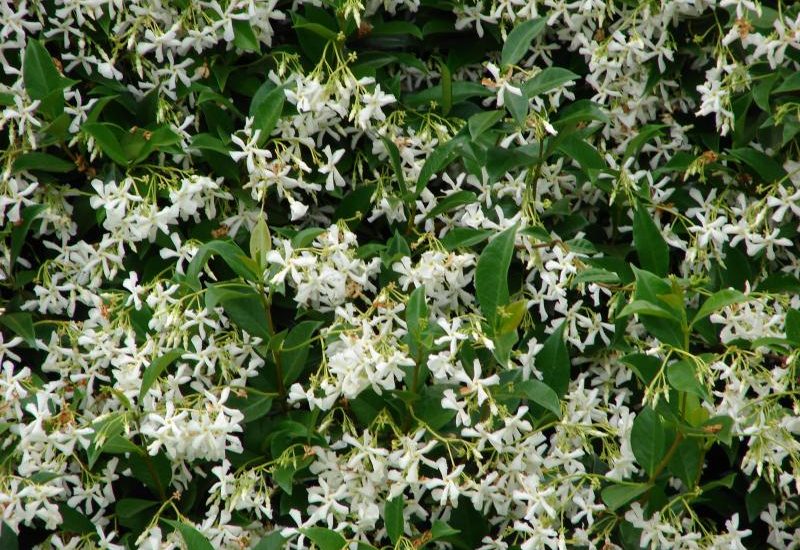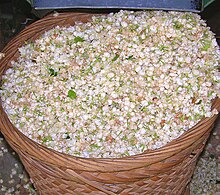Jasmine can be either deciduous (leaves falling in autumn) or evergreen (green all year round), and can be erect, spreading, or climbing shrubs and vines. Their leaves are borne, opposite or alternate. They can be simple, trifoliate, or pinnate. The flowers are typically around 2.5 cm (0.98 in) in diameter. They are white or yellow in color, although in rare instances they can be slightly reddish. The flowers are borne in cymose clusters with a minimum of three flowers, though they can also be solitary on the ends of branchlets. Each flower has about four to nine petals, two locules, and one to four ovules. They have two stamens with very short filaments. The bracts are linear or ovate. The calyx is bell-shaped. They are usually very fragrant. The fruits of jasmines are berries that turn black when ripe.
Cultivation and uses
Widely cultivated for its flowers, jasmine is enjoyed in the garden, as a house plant, and as cut flowers. The flowers are worn by women in their hair in southern and southeast Asia.
Jasmine tea
Jasmine tea is often consumed in China, where it is called jasmine-flower tea (茉莉花茶; pinyin: mò lì huā chá). Jasminum sambac flowers are also used to make jasmine tea, which often has a base of green tea or white tea, but sometimes an Oolong base is used. The flowers are put in machines that control temperature and humidity. It takes about four hours for the jasmine blossoms to absorb the fragrance and flavour. For the highest grades of jasmine tea, this process may be repeated up to seven times. It must be refired to prevent spoilage. The used flowers may be removed from the final product, as the flowers contain no more aroma. Giant fans are used to blow away and remove the petals from the denser tea leaves.
Γιασεμί
Το γιασεμί ή ίασμος(αρχ. ελλ. επίθετο ιάσμινον (εξ ιάσμης) και Ιάσμη) (λατ. Jasminum) είναι γένος αγγειόσπερμων, δικότυλων φυτών το οποίο ανήκει στην οικογένεια των Ελαιίδων (Oleaceae).
Η λατινική λέξη Jasminum προέρχεται από την ελληνική λέξη ιάσμινον (μύρον) δηλαδή ιασμέλαιο και η ελληνική ανάγεται στην περσική λέξη yâsamin (یاسمین) ή yāsam.
Υπάρχουν 300 περίπου είδη που απαντώνται στις εύκρατες και θερμές χώρες της γης.
Είναι αναρριχώμενος θάμνος, συνήθως αειθαλής αλλά και φυλλοβόλος.
Χρήσεις
Από το γιασεμί εξάγεται ένα αιθέριο έλαιο γνωστό με την ονομασία ιασμέλαιο. Για την εξαγωγή αυτού του ελαίου χρησιμοποιούνται 2 μέθοδοι, η απόσταξη και η εκχύλιση.
Το αιθέριο έλαιο αυτό χρησιμοποιείται στην αρωματοποιία. Περιέχει λινολικό οξύ, γερανιόλη, βενζυλικό οξύ, ευγενόλη, τερπινεόλη και λιναλοόλη. Είναι απαραίτητο συστατικό σχεδόν όλων των αρωμάτων.
Η Γαλλία είναι πρώτη στον κόσμο στην παραγωγή ιασμελαίου. Ακολουθούν η Κίνα, η Ιταλία, η Αίγυπτος και η Ελλάδα.




